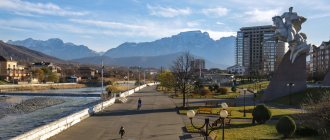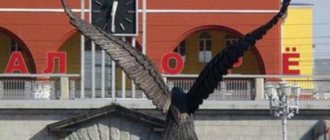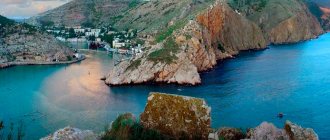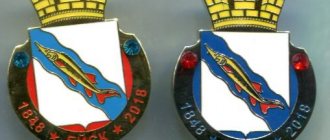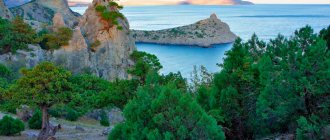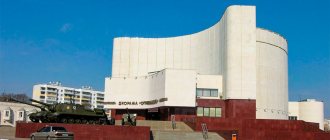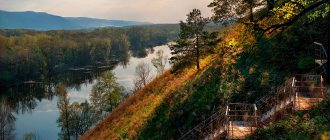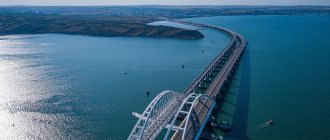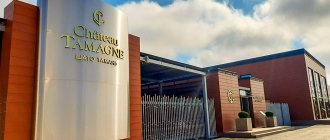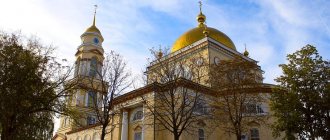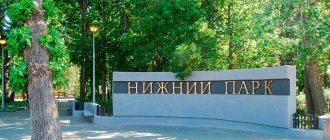Chelyabinsk Arbat
First of all, in Chelyabinsk you should go to the most beautiful and memorable street in the city. The idea to create your own Arbat appeared in 2000: as a result, part of Kirov Street turned into a real cultural masterpiece. Young and cozy “Kirovka,” as it was affectionately nicknamed by local residents, has become a place where mass celebrations and flash mobs take place, musicians sing songs, and artists offer their canvases. There are also many attractions of Chelyabinsk, including preserved unique old merchant houses, nice bronze sculptures and interesting monuments. Chelyabinsk Arbat creates a special spiritual atmosphere.
Chelyabinsk Museum of Fine Arts (art gallery)
Chelyabinsk Museum of Fine Arts (Picture…
Chelyabinsk
The Chelyabinsk Museum of Fine Arts is the only classical art museum in the Southern Urals. Its history began in 1940, when a city art gallery was opened in the Alexander Nevsky Church. Today the exhibition is located on two museum sites - in the building of the former Yakushev Brothers trading house and in a house on Revolution Square.
The museum collection includes rare examples of icon painting from the 16th to 19th centuries, handwritten and early printed books. The collection of Ural art includes works by Chelyabinsk painters and graphic artists, Kusinsky and Kasli iron casting masters. The pride of the museum is masterpieces of world art, among them works by Ivan Shishkin, Ivan Aivazovsky, Isaac Levitan, Ivan Kramskoy and Dmitry Levitsky.
Church of the Holy Trinity
Another interesting attraction of Chelyabinsk, a must-see, is the Trinity Cathedral. It was originally a modest wooden structure erected in 1829. In 1914, the building could no longer accommodate all the believers, so the church was dismantled, and a cathedral with a bell tower was erected in its place. During the years of Soviet power, the domes were dismantled, and the building itself was converted into a local history museum. In 1990, the cathedral was finally returned to the diocese. As a result of long and complex work, the temple was restored to its former grandeur: the unique painting in the Vasnetsov style and acoustics were restored.
Modern architecture of Chelyabinsk
In the last decade, the city has seen a real construction boom. New multi-storey buildings have sprung up in residential areas, and town houses are being actively built. The modern appearance of Chelyabinsk is formed thanks to the rather powerful creative potential of local architects.
Vice-mayor of the city Vladimir Slobodskoy calls the business building one of the most successful examples of modern architecture in the city. In his opinion, it fit perfectly into the ensemble of the ancient buildings of Chelyabinsk and somewhat enlivened it. But Vladimir Slobodskoy considers the so-called iron on the Scarlet Field – a vague structure of unknown purpose – to be a real “architectural failure”.
Modern Chelyabinsk is developing and actively being built. So, on the site of an unused industrial zone, a new shopping and entertainment center grew up. In recent years, the city's railway station has been reconstructed and a number of new churches and sports facilities have been built. Next, we will try to highlight the most interesting modern buildings in Chelyabinsk from an architectural point of view.
Arena "Tractor"
One of the most visited tourist places in Chelyabinsk is the Traktor Arena. The modern ice rink was designed with the greatest possible comfort for its spectators. The three-story building, the construction of which began in 2007, is designed in high-tech style. The main feature of the arena is the ability to quickly transform into a stage within a couple of hours, without the need to defrost the ice. Thanks to this, in addition to sports matches and competitions, the arena can host concerts and exhibitions.
Chelyabinsk city: architecture and construction
As for the architectural appearance of Chelyabinsk, many bloggers, cultural and public figures of the country did not speak very flatteringly about it. Some of them rather harshly stated that such concepts as architecture and design were, in principle, alien to this city.
Chelyabinsk, according to director Alexander Sokurov, is “unkempt and faceless.” The popular rapper Basta spoke about the “architectural degradation of the city,” and the artist and sculptor Mikhail Shemyakin spoke about the scarcity of urban architecture. The famous blogger Ilya Varlamov once noted that the architecture of Chelyabinsk is “a complete mess of buildings of different eras and styles.” At the same time, he was incredibly impressed by the appearance and design of the ChMZ area.
Indeed, there are few outstanding buildings and structures in this city, because Chelyabinsk began to be actively developed only in the second half of the 19th century. In addition, many old and valuable buildings (in particular, religious ones) were destroyed by the Bolsheviks. Nevertheless, the architecture of Chelyabinsk is represented by five different styles. This:
- classicism (a striking example is the building of a tobacco factory);
- Art Nouveau (Danziger's mansion, Yakushev's arcade and other buildings);
- eclecticism (Znamya cinema);
- Stalin Empire style (state university building);
- modern style, or hi-tech.
The city's temple architecture is also of some interest. Chelyabinsk can boast to tourists of its beautiful St. Simeon Cathedral, lavishly decorated with patterns and stucco. The brick Holy Trinity Church, built at the beginning of the 20th century, is also impressive in its appearance.
Chelyabinsk State Museum of Local Lore
Every art lover should definitely visit the main museum of the city in Chelyabinsk, which is now better known as the State Historical Museum of the Southern Urals. It began its existence in 1913 thanks to a group of enthusiasts who organized the collection of collections and exhibits. The opening ceremony took place in 1923. The museum's fund includes more than 250 thousand items - this is a unique treasury of the historical, cultural and spiritual heritage of the region. Of particular interest among the museum exhibits is the largest fragment of the Chelyabinsk meteorite found, weighing over 500 kg.
History of Chelyabinsk
Chelyabinsk was founded in 1736 as a fortress on the site of the Bashkir village of Chelyaba. Its founder is considered to be Colonel A.I. Tevkelev. The Chelyabinsk fortress was necessary to protect against attacks by the Bashkirs and to protect food convoys that moved along the road from Techenskaya Sloboda to the Orenburg fortress. During the Peasant War, in 1774, the fortress withstood the siege of the Pugachev rebels, but in February 1775, the Chelyabinsk fortress was captured.
Monument to the founders of Chelyabinsk
In 1743–81, Chelyabinsk was the center of the Iset province. In 1781 it received the status of a city and became the center of the Chelyabinsk district of the Yekaterinburg region of the Perm governorship, and a year later it was assigned to the Ufa governorship. Since 1796, in connection with the abolition of governorships, Chelyabinsk, together with the district, became part of the Orenburg province.
In 1782, Catherine II approved the coat of arms of Chelyabinsk with the image of a camel, which symbolized the passage of trade routes through the city - “a loaded camel as a sign that they are brought to this city with goods.”
Sculpture with camels on Chelyabinsk Arbat
In 1788 in Chelyabinsk, a group of doctors led by S.S. Andreevsky studied anthrax and they created the first serum against this extremely dangerous, deadly disease.
After the construction of the Samara-Zlatoust railway in 1892, connecting Chelyabinsk with Moscow, the city began to actively develop. Construction of the Trans-Siberian Railway continued from Chelyabinsk. Trade was actively developing. Chelyabinsk has become the leader in Russia in the trade of bread, as well as the second in the trade of imported tea. It was called the “Gateway to Siberia.”
Since the 1890s, Chelyabinsk was the route of numerous immigrants heading to Siberia. The largest medical and nutritional resettlement center in the country operated near the railway station. Hundreds of thousands of people passed through it. On some days, up to 25 thousand people gathered at the Chelyabinsk station.
Monument to the founders of the city on Kirovka
If in 1897 only about 20 thousand people lived in Chelyabinsk, then by 1917 the population was already approaching 70 thousand. For its rapid growth, some observers called Chelyabinsk the Trans-Ural Chicago. Growth continued during Soviet times. In 1976, the millionth resident was born here.
In May 1918, an armed mutiny of the Czechoslovak Corps occurred at the Chelyabinsk railway station, after which the fire of the Civil War flared up in the Southern Urals. In July 1919 the city returned to the Bolsheviks.
On September 3, 1919, Chelyabinsk became the center of the created Chelyabinsk province, and on November 3, 1924, the center of the Chelyabinsk district of the vast Ural region. On January 17, 1934, the Chelyabinsk region was created. It is interesting that in 1937 the issue of renaming Chelyabinsk to Kaganovichgrad was considered.
During the first five-year plans and during the Great Patriotic War, many factories appeared here. The former trading city has turned into a large industrial center. During the war, about 70 enterprises were evacuated here from the central part of the country. In just 33 days, the Chelyabinsk Tractor Plant, which merged with two evacuated enterprises, mastered the serial production of T-34 tanks. Here, the assembly of tanks was put on the assembly line for the first time, and then the experience was adopted by Uralvagonzavod in Nizhny Tagil. During the Great Patriotic War, Chelyabinsk provided the front with 16,323 tanks and self-propelled guns, 43,811 tank engines, 85 thousand sets of fuel equipment, and a large number of artillery and mortar ammunition corps. By the end of the war, every third tank and combat aircraft contained Chelyabinsk steel. Informally, Chelyabinsk began to be called Tankograd.
Monument to volunteer tankers on Glory Boulevard
By 1980, the city's enterprises produced more than half of the all-Union production of stainless steel, a fifth of pipes produced in the USSR, a third of ferroalloys, and up to 40% of road vehicles. Today it is still one of the largest industrial centers in the country.
Chelyabinsk suffers greatly from air pollution and other environmental problems. Every year, the Chelyabinsk region takes last or penultimate place in the environmental rating. Even the meme “The City That Smog” was born (smog in this case is not a verb, but a noun meaning dirty air). An even more common meme is “Harsh Chelyabinsk.”
On the morning of February 15, 2013, a huge meteorite, called Chelyabinsk, entered the Earth’s atmosphere near the city. It was the largest meteorite to hit Earth in at least the last century. Chelyabinsk and its surroundings were heavily damaged due to the blast wave. Many window panes were broken, and more than 1 thousand people were cut by fragments. The largest fragment of the meteorite fell into Lake Chebarkul. Now it can be seen in Chelyabinsk in the Historical Museum of the Southern Urals.
5. Scarlet Field
One of the most interesting attractions in Chelyabinsk for tourists is the quiet and well-kept recreation park “Aloe Field”, located in the very heart of the city. Back in 1905, a rally of workers from Chelyabinsk factories and workshops took place at this site, which was brutally suppressed. In memory of those bloody events, the name “Scarlet Field” arose. On the territory of the park there is a children's creativity palace, an imitation of Lenin's mausoleum and the Eaglet monument.
Monuments of military glory in Chelyabinsk
During the Patriotic War, more than 100 thousand Chelyabinsk residents went to the battlefields. Every second of them did not return home. And in memory of those who fought and who worked in the rear, monuments were erected in Chelyabinsk, which are memorial places of the city.
Guests of Chelyabinsk can get involved in military history and visit some of them:
- Between Kirov and Tswilling streets in May 1965, in memory of the fallen Chelyabinsk residents, on the occasion of the twentieth anniversary of the Victory, an eternal flame was lit. The names of 250 South Urals residents are carved on the slabs around it.
- Nearby you can see a monument in honor of the Chelyabinsk volunteer tankers. The monument was opened in May 1975. Its authors were the sculptor Golovnitsky and the architect Alexandrov.
- The monument “Feat” (second name “Alyosha”) is located on the street. Red near gymnasium No. 1, created in honor of those who studied and worked at the school and died during the Patriotic War. The monument was opened in September 1970. Authors: sculptor Viktor Bokarev and architect Ilya Talalay.
- Memorial “Memory” is located on the street. Blucher, better known as “Grieving Mothers”, was erected in memory of those soldiers who died in the city’s hospitals during the war. According to the idea of two sculptors Golovnitsky, the women are the mother and wife of the deceased soldier. The opening of the monument took place on May 8, 1975.
- “Sister” is one of the youngest monuments in the city, which is dedicated to all the women who fought during the Patriotic War. Its opening took place in May 2005 and is located at the intersection of Pobeda Avenue and st. Kyshtymskaya. The sculptor of “Sister” is Alexey Tishin. Funds for the monument were allocated by city entrepreneurs and ex-regional governor Pyotr Sumin.
Monument "Eaglet"
Tourists who take a walk along the Scarlet Field will definitely see the “Eaglet” monument, which was erected in October 1958 for the 40th anniversary of the Komsomol. The height of the monument is 4 m. Authors: sculptor Lev Golovnitsky and architect Evgeny Alexandrov.
“Eaglet” is a young Red Guard hero, whom the sculptor depicted as facing death. The young man's hands are tied tightly behind him. He knows that he will soon die, but at the same time he indomitably believes in victory. “Eaglet” is a dedication to all Komsomol members who took part in the revolution and civil war in the Urals.
The youth of the city of Chelyabinsk earned funds for the memorial through subbotniks and Sundays.
Monument "Tale of the Urals"
Anyone who comes to Chelyabinsk by rail will find attractions right on the square in front of the station. For 50 years now, the “Tale of the Urals” monument has been the hallmark of the city - a granite hero with a hammer in his hands, symbolizing the strength of the working Urals. The author is the famous Ural sculptor Vitaly Zaikov. The monument reaches 12 meters in height.
At the bottom of the facade is carved: “The Urals are the supporting edge of the state, its earner and blacksmith.” The hero rose above the station square of Chelyabinsk in 1967.
3 times in 2009, 2010 and 2011, with the help of Chelyabinsk entrepreneurs and with the support of the city administration, the giant changed his traditional clothes to the festive outfit of Grandfather Frost. Moreover, the eight-meter outfit of 2010 was even included in the Russian book of records for its enormous size.
In total, it took 300 meters of velvet, faux fur and padding polyester to sew this New Year's caftan. There is such a sign that if you touch a hero and make a wish, it will definitely come true, the Urals will help with this.
Lake Smolino
In the southeast of Chelyabinsk the waves of the region's best natural attraction splash. Lake Smolino is a natural slightly salted reservoir, which has been listed as a natural monument since 1969. Smolino is a fragment of an ancient sea - the waters filled a bowl with a clay bottom. Once upon a time, the silt and mud of the lake had healing properties, and swimming in its waters had a beneficial effect on the body and cured many diseases. Now the lake is heavily polluted due to its proximity to a large industrial center and the Shershnevsky reservoir.
Best hotels in Chelyabinsk
Related materials:
- 22 best attractions of Grozny that are worth...
- 37 must-see attractions in Dubai
- 33 attractions of Ulyanovsk recommended for…
- 43 best attractions in Minsk, recommended for…
- 43 attractions of Adler that are worth seeing
- 35 attractions of Volgograd recommended for…
- 29 Cheboksary attractions recommended for…
- 29 best attractions in Orel, recommended for…
- 30 best sights of Ufa
Did you like the article? Share with friends:
Opera and Ballet Theater named after M. V. Glinka
The function of artistic and moral education of residents has long rested on the mighty shoulders of the Opera and Ballet Theater, the construction of which began in 1937. The repertoire widely includes classical operas by Soviet and Western European composers, as well as familiar ballet performances in new interpretations. The uniform style, manner, and composition of the ballet troupe helped to win many prizes, awards and titles.
Main building of SUSU
Without any exaggeration, the main building of South Ural State University can be called the main architectural symbol of the city of Chelyabinsk. The building was built in 1943 in the Stalinist Empire style. A majestic central tower with a spire was planned in the original design, but it was built much later. In 2003, the roof of the building was decorated with two impressive black sculptures of Prometheus and the goddess of Glory.
The main building of the university is one of the tallest buildings in Chelyabinsk and is mandatory included in all excursion routes around the city.
Chelyabinsk Zoo
In order to spend a memorable day full of positive emotions, it is worth visiting the Chelyabinsk City Zoo. Chelyabinsk residents are proud of their unique zoo, where visitors will get acquainted with many rare exotic animals, including: kangaroos, bears, sloths, leopards, tigers, monkeys, birds. In addition, the zoo presented tropical insects for the first time in the Asian part of the country. Of the permanent inhabitants of the zoo, 84 species are listed in the International Red Book. A walk through the zoo will captivate both children and adults: there really is something to see here.
Holy Trinity Church
The largest of the pre-revolutionary churches in Chelyabinsk is the Holy Trinity Church. Its construction began in 1911 and lasted three years. The temple did not perform its functions for long: with the advent of Soviet power, the church was closed. At first, the Bolsheviks planned to convert the temple into a cinema, but then they changed their minds and placed one of the exhibitions of the city museum here.
Today, the Holy Trinity Church stands next to a busy road and, against the backdrop of multi-story new buildings, looks even more ancient. The walls of the temple are made of red-brown brick and decorated with restrained decor. Inside the church, tourists can see a luxurious iconostasis made of cedar wood.
Museum of entertaining science "Experimentus"
The youngest and most amazing museum in the city has already won love and popularity among its residents. Dozens of amazing experiments can be carried out independently in this unusual museum. The exhibits not only demonstrate physical and chemical phenomena, but also make them visual and entertaining, which not every museum can boast of. Here you can literally touch a tornado, look at yourself through the eyes of a predator, or launch lightning from your hands. At the same time, practical experiments will be equally exciting both for children, who will not be distracted from launching new mechanisms, and for adults, for whom the museum’s exhibits will seem to take them back to their school years. This is one of the best places in Chelyabinsk to visit with children.
Where to go with a child in Chelyabinsk
The city will offer a special program to its guests traveling with children. Young tourists will be able to see a lot of interesting things, attend colorful performances, and come into contact with wildlife.
Separate article: Entertainment in Chelyabinsk for children
Museum "Experimentus"
- Opening hours: daily, from 10:00 to 20:00.
- Ticket price: adult from 400 rub. up to 590 rub., children from 300 rub. up to 490 rub.
- Telephone.
- Website: https://www.experimentus.ru
- Address: st. Ordzhonikidze, 58A, building 3. Transport stop “City Garden”.
A visit to this unique museum will leave a lot of impressions on all family members. There are more than 120 interactive exhibits here that help you understand the essence of the complex physical and chemical processes that fill the world around you. Children are given a lot of useful knowledge in an accessible form. Children will be able to take part in exciting experiments themselves and become participants in master classes. They will learn how a battery works, learn to read encrypted messages and even hammer a nail into a banana. Be sure to give your child a journey into the world of amazing discoveries.
Chelyabinsk Zoo
- Opening hours: daily, from 10:00 to 20:00 and from 10:00 to 18:00 in winter.
- Ticket price: adult 150 rubles, children under 12 years old 80 rubles, children under 5 years old free.
- Phone: +7 351 263‑18-64.
- Website: https://www.chelzoo.ru
- Address: st. Truda, 191. Transport stop "Zoo".
The city zoo, founded in 1996, is considered one of the most dynamically developing institutions of its type in the country. It covers an area of about 8.5 hectares, which allows creating excellent conditions for the 133 species of animals, birds and reptiles kept here. The administration does a lot for young visitors. For several years now, a children's petting zoo has been operating, where children can play with animals. The installation “The Lost World” recently opened. Children love to play among the life-size dinosaur sculptures, and city visitors love to take pictures with the prehistoric reptiles in the background.
City Circus
- Opening hours: performances are given from Wednesday to Sunday inclusive. Shows start at 18:30 on weekdays, at 13:00 and 17:00 on weekends.
- Ticket price: from 800 rub. up to 1500 rub.
- Telephone.
- Website: https://www.circus-chelyabinsk.ru
- Address: st. Kirova, 25. Transport stop "Circus".
The Chelyabinsk circus dates its history back to 1901, when a permanent building was built for performances by artists of the original genre touring the Urals. Today, circus troupes demonstrate their skills in another building, built in 1980 and capable of accommodating 1,814 spectators. The performances at the local arena are incredibly colorful. The enchanting performances of trainers, jugglers, acrobats, and illusionists are supported by magnificent color and musical accompaniment. An amazing show that will undoubtedly delight your child.
You may be interested in interesting places in Chebarkul, Satka, Miass, Troitsk, Magnitogorsk, Khanty-Mansiysk, Kyshtym, Kurgan, Tyumen and Yekaterinburg.
The colorful sights of the city can surprise and delight even the most experienced traveler. In the most interesting places in Chelyabinsk you can take beautiful photographs that will remind you of a great vacation for a long time.
Alexander Nevsky Church
One of the most famous and majestic religious attractions of Chelyabinsk is the Alexander Nevsky Temple. The bright red brick creation is located in the very center of the city. The church was founded in 1907, the temple was distinguished by a new facade style at that time - Russian-Byzantine. During Soviet times, the church was closed, and the building housed a printing shop. In 1986, the building was transferred to the Philharmonic Society, organizing an organ music hall. The temple was returned to the Russian Orthodox Church in 2010, at which time services and ceremonies were resumed.
Sights of Chelyabinsk
In the center, you can start exploring the city from the State Historical Museum of the Southern Urals (Truda St., 100, tel. 263-08-32). It was founded on July 1, 1923 as the Museum of the Local Region. In 2006, a new spacious building was built specifically for the museum on the banks of the Miass River. The permanent exhibition consists of three large halls: “Hall of Nature and Ancient History”, “Hall of History and Folk Life”, “Hall of History of the 20th Century”. There is a fairly rich archaeological collection here. The museum also hosts various temporary exhibitions. In the summer there is an exhibition on the observation deck on the roof. In the museum you can see the largest fragment of the famous Chelyabinsk meteorite. For information about other Chelyabinsk museums, see a separate review.
Nearby is the Rock Garden , and behind it, near the Megapolis Cultural Center, the Ferris wheel “360” (51a Sverdlovsky Prospekt). It is considered the highest all-season mountain in Russia (73 meters). The wheel is equipped with comfortable 6-seater panoramic cabins. The viewing range is up to 5 km in any direction.
On the other bank you can see the unusual building of the Shopping Center (Kaslinskaya St., 64). It is quite unique from an architectural point of view. Built according to a design by the Moscow Giprotorg Institute, which at that time had no analogues in the world. The roof of the building is a reinforced concrete dome measuring 102x102 m, and there are no internal columns. The structure rests on the corners. Special rollers allow the dome to shrink or expand slightly depending on the ambient temperature. The dome area is more than 1 hectare, weight is over 5000 tons. A model of the dome was exhibited at the international exhibition in New York in 1974 and in London in 1978. In 1976, the project received a first degree diploma at VDNKh.
Next to the Ferris wheel, in the Yunost sports palace, there is a Chelyabinsk bus station.
Let's go on the other side of the historical museum. A monument to S.S. is erected here. Prokofiev - an outstanding Russian and Soviet composer. He is depicted sitting on an armchair with an open music book lying on his knee. The monument was made by sculptor V.A. Avakyan.
The Trinity Bridge was built nearby . Here was the oldest crossing across the Miass in the city. The bridge is lined with granite, decorated with Kasli casting, and is illuminated in the evening.
On the other bank, near the bridge, in the park near the Rodina organ hall, in November 2022, a monument to Pyotr Stolypin , Chairman of the Council of Ministers of the Russian Empire, was unveiled. The author is sculptor Anton Plokhotsky. According to the initiators of the installation of the monument, Stolypin’s reforms gave impetus to the development of Chelyabinsk. The building itself was built in 1950 in the Stalinist Empire style for the Rodina cinema.
But let's go back across the bridge. On the other side of the bridge stands the building of the concert hall named after. S.S. Prokofiev (Truda St., 92a). It represents the thrice rebuilt former shops of the merchant Akhmetov (1880-1902), and the merchant Galeev (1905). In 1929, these two stores were rebuilt into the Proletary cinema. In 1946-48, according to the design of architect K.D. Evteev, the former cinema building was reconstructed into a musical theater. In 1948, the building housed the Chelyabinsk Operetta Theater, and on August 1, 1950, the building was transferred to the Chelyabinsk Philharmonic.
On the other side of Truda Street is Yaroslavsky Square, where the Nativity of Christ Cathedral used to stand, demolished in 1932, and now the Chelyabinsk State Academic Opera and Ballet Theater . M.I. Glinka. The theater building was supposed to be commissioned in 1941, but the war intervened in the plans and the evacuated factory moved in. The theater building was finally completed only in 1955.
In 2004, a monument to M.I. Glinka . The composer is depicted in full height. With one hand he leans on a large music book, and in the other he holds an accordion. Sculptor: V.A. Avakyan, architect E.V. Alexandrov. There is a beautiful fountain nearby.
From here begins the main central attraction of the city - the pedestrian street Kirovka . In my opinion, it is the most pleasant and interesting of the pedestrian streets in the entire Urals (and even better than Moscow’s Arbat). Kirovka was opened in 2004. It occupies a section of Kirova Street from Trud to Lenin, its length is approximately 820 m.
If you walk along Kirovka from the Miass River, you will first come across a monument to the founders of the city . At the base of the high spire with the figure of the Archangel Michael there are four bronze figures: a Cossack with a pike, a Bashkir, a peasant with a saw and officer Tevkelev - the founder of the fortress. On the sides of the stele there are information boards with excerpts from archival documents. By the way, it was at the intersection of Truda and Kirov streets that the Chelyabinsk Fortress was built in 1736.
Nearby are the sculptures “Mother, Child and Dove”, “Hands, Ball and Cap”, “TV Camera”, “A.S. Pushkin" (according to another version "Onegin"). Further down the street you will see the sculptures “Fireman”, “Carriage and Page”, “Lefty Shoeing a Flea”, “Artist”. At the intersection with Marx Street, you can pay attention to the art object “Zodiac Signs”: 12 signs are depicted on square metal tiles and built into the asphalt in a chaotic manner.
Next is a monument to internationalist soldiers. Here sits a bronze warrior with a guitar (remarkably similar to Alexander Rosenbaum), and next to it is a stone with an excerpt from the song “Black Tulip”. Nearby stands the business building (Kirova St., 159) - the city’s first skyscraper, 23 floors high, built in 2004-07. There is an observation deck here.
Walking further along Kirovka, you will come across the sculptures “Postman”, “Shoe Shine Man”, “Zero Mile”. The Main Post Office is located nearby. the Boulevard of Glory adjacent to Kirovka there is a monument to those who fell in the Great Patriotic War with the Eternal Flame and a monument to volunteer tankers.
Nearby there are the following sculptures : “Veteran”, “Carrier”, “Boy with Camels”, a monument to a penny, an art object “Bench of Love”. But that’s not all! Further on, on the Chelyabinsk Arbat there are sculptures “Fashionista Lady” with a mirror, “Saxophonist”, “Walker” (“Law”), “Policeman”. Decorative gates are installed at the entrance to Kirovka from Lenin.
Kirovka consists almost entirely of beautiful old merchant houses - architectural monuments. They have been well restored. Among such buildings is the house of merchant N.A. Samokhvalov (1898, Kirova St., 82), apartment buildings of A.P. Kholodov (1896-1906, Kirova St., 139), house of Ya.S. Plonsky (1902, Kirova St., 141), house of L.Ya. Meltser (1902-07, Kirova St., 88), Zlokazov’s store (1893-1900s, Kirova St., 92), house of merchant S.T. Sharlova (1883-84, Kirova St., 100), shop M.F. Valeeva (1911, Kirova St., 104), electrotheater "Lux" (Kirova St., 114), branch of the State Bank of the Russian Empire (1910, Kirova, 114) and others. And on the house at the address Lenin Ave., 54 / Kirova, 177, a memorial plaque to A.L. Chizhevsky. The outstanding scientist, founder of geleo-cosmobiology, thinker Alexander Leonidovich Chizhevsky (1897-1964) lived in this house until his arrest in 1942. The house in which V.K. worked has also been preserved. Blucher.
Truda Street is also rich in old houses : the Stakheev store, the Shikhov-Pokrovsky house (1850s, Truda St., 98), the arcade and house of the Yaushev brothers (Truda St., 92a and 92), the house of the doctor V.G. Zhukovsky (Truda St., 88), the Smolin-Novikov house (1820s, Truda St., 86), the house of the Stepanov brothers (Truda St., 82), the house of V.M. Kolbina (Truda St., 66). On other Chelyabinsk streets you can see the Danziger-Vysotsky mansion (1911, Pushkin St., 1), the mansion of M.P. Arkhipov (1911, Kommuny St., 68), house of G.A. Bashkirov (1908, Vasenko St., 25), building of the tea-packing factory A.G. Kuznetsov (1904, Vasenko St., 37), Lorentsov's mansion (Krasnoarmeyskaya St., 100), house of Lieutenant Zhemchuzhnikov (1894, Karl Marx St., 50), mansion of A.V. Breslina (Zwillinga, 15).
But let's return to Kirovka. Revolution Square begins . The architectural ensemble surrounding the square was formed by the end of the 1950s. As expected, there is a monument to V.I. Lenin. In the summer there is a “singing” light and music fountain on the square, and in the winter an ice town is built here.
To the side of Revolution Square, on the corner of Lenin - Vorovsky, there is the building of the Arbitration Court , which is an architectural monument. It was built in 1934. They started to build in the constructivist style, but at the last stages of construction it was rebuilt into neoclassical. Near this building on Vorovskogo Street there is a sculpture made from scrap metal “Venus” , the attitude towards which is ambiguous among the townspeople.
In general, Lenin Avenue in this part is interesting for the architecture of Stalin’s time , among which there are interesting examples of neoclassicism. Here you can pay attention to the buildings of the NKVD Town (1936, Lenin Ave., 63-67), the house of the architect T. Ervald (1937, Lenin Ave., 61, 62), the Public Library, the Bank of Russia, the house of employees of the Regional Executive Committee (1938, Ave. Lenina, 54), hotel "South Ural" (1935-41), residential buildings of the 1930s (Lenina Ave., 49, 50). The Soviet buildings of the city administration (1958, Revolution Square, 2), Chelyabenergo (1955), and the South Ural Railway Administration (1937-42, Revolution Square, 3) also overlook Revolution Square.
Revolution Square smoothly turns into Theater Square . There is a sculpture “Camel” . Its author, Rafael Saifullin, lives in Finland, and the bronze sculpture was cast in Milan. The history of Chelyabinsk is shown on the camel using symbols. Here you can see images of the fortress, Sarmatians, tanks, tractors, meteorite, etc. The sculpture is very interesting and multifaceted. In my opinion, this is the most interesting monument in Chelyabinsk.
Above is the Chelyabinsk State Academic Drama Theater named after. N.Yu. Orlova (Revolution Square, 6), built in 1973-82. In plan, the building has an oval shape, lined with marble slabs (marble was brought from Koelga), the decorative entrance group is made of Kasli cast iron. The building has two theater halls: a large one with 900 seats and a small one with 150 seats. Bears the name of director N.Yu. Orlov, who directed the theater for 30 years. The building is a cultural heritage site of regional significance.
Behind the drama theater begins a rather cozy city garden named after. A.S. Pushkin . It was created back in 1904-09, and received its name in honor of the famous poet and writer in 1937 - on the centenary of his death. Here you can see the monument to A.S. Pushkin, the sculptural composition “Tatiana Larina’s Bench”, the monument “Red Communard Steam Locomotive”, a memorial stone in honor of the 150th anniversary of V.I. Vernadsky, rotunda with griffins, fountain. The attractions are open. Sometimes city holidays and festivals are held here.
Nearby is the most unusual building in Chelyabinsk - the former elevator of the State Bank (Kirova St., 130v/1). It was built in 1914-16 under the direction of engineer K.E. Zhukov, worked until the 1990s. The abandoned building, built in the Gothic style, looks creepy. Thanks to its unusual appearance, it has the reputation of a mystical, mysterious place.
Nearby, near the intersection of Vorovsky and Krasnaya streets, there is another architectural monument - a water tower . It was built in 1911-12. Previously, this was the outskirts of the city, its highest point at that time. The height of the tower was 12.5 m. Its capacity was 15 thousand buckets (or 185 cubic meters). The lower floors of the tower are brick, and the upper floor is wooden. The tower has elements of Art Nouveau style. The Chelyabinsk water supply system began from this tower (by the way, it appeared 13 years earlier than the Yekaterinburg one).
Not far from the tower, in a park near the Ural shopping center on the street. Vorovsky, there is a sculptural composition “Sphere of Love” - the most romantic place in the city. Along the edges there are sculptures in the form of bronze trees that hold a blue glass dome. It symbolizes the firmament on which you can see the signs of the zodiac. The dimensions are impressive: height 12 m, diameter of the dome 10 m. Under the dome are images of a young man and a girl in love reaching towards each other. The stone on the right symbolizes the masculine principle, and on the left – the feminine. Chelyabinsk newlyweds come here. Author: sculptor V.F. Mitroshin.
On Lenin Avenue between Krasnaya and Sverdlovsky Prospekt streets there is Aloe Pole Square . Here you can see the “Eaglet” monument , erected in 1958 and dedicated to the victims of the Civil War. This boy, a hero of the Civil War, is depicted wearing the things of an adult: a hat with a ribbon, a hood, an overcoat to the toes, and excessively large boots. Heavy military clothing creates a contrast with the youthful body and childish face. The face looks courageous and internally tense. The bronze figure was cast in Leningrad, and the pedestal is lined with polished red Zhitomir granite. Sculptor L.N. Golovnitsky, architect E.V. Alexandrov. It has the status of a historical and cultural monument of federal significance.
There is also a memorial in honor of the pioneer heroes . This is a complex of 12 cast-iron bas-reliefs installed on pedestals along the perimeter of a small area. Each bas-relief depicts one of the twelve pioneers - heroes of the Civil and Patriotic Wars. Among them are Pavlik Morozov, Marat Kazei, Zina Portnova, Lenya Golikov, Volodya Dubinin, Sasha Chekalin and others.
The monument-mausoleum of V.I. is also worth seeing on the Scarlet Field. Lenin is one of the most unusual monuments to the leader of the world proletariat. Outwardly, it resembles a mausoleum with elements of oriental motifs. The two-story building is made of granite. Two side staircases lead to the second floor. On the second floor, in a niche between two columns, there is a bronze bust of V.I. Lenin. This monument is the first monument to Lenin in the Urals. The decision to perpetuate the memory of Lenin was made by Chelyabinsk residents just two days after the death of the leader. The first stone was laid on January 27, 1924 at 18:05 local time, synchronously with the funeral ceremony of burying the body in a mausoleum in Moscow.
The bronze bust of Lenin was made by Leningrad sculptor Vasily Kozlov from the death plaster mask of Ilyich. Cast on . The progress of the work was supervised by Vera Mukhina. The grand opening of the monument took place on July 15, 1925. The event was timed to coincide with the sixth anniversary of the liberation of Chelyabinsk from the White Guards. After the opening, the monument-mausoleum served as a public library, where the works of V.I. were presented. Lenin, and during rallies it was used as a platform.
In the center of the Scarlet Field square stands the Church of Alexander Nevsky . It was built in 1911 from red brick, decorated with brick decor in the neo-Russian style. It has a three-tiered tented bell tower. During Soviet times, the church was closed. Its space was divided into two floors; it housed a printing house, a regional art gallery, a planetarium, and technical clubs of the Palace of Pioneers and schoolchildren. Since 1987, the building has been occupied by the Chamber and Organ Music Hall. In 2013, the building was returned to the Russian Orthodox Church.
Moving further along Lenin Avenue, pay attention to the main building of the South Ural State University (Lenin Avenue, 76). Externally, the building is very reminiscent of Moscow State University in Moscow. In addition, the top façade is decorated with sculptures of Prometheus and Nike (students jokingly call them “gargoyles”). And in front of the entrance there is a sculpture to the “eternal student”.
At the end of Lenin Avenue in the center of Science Square there is a monument to Academician I.V. Kurchatov . The composition includes two pylons and a statue of Kurchatov on a pedestal located between them. The hemispheres on the pylons symbolize the split atom. The height of the pylons is 27 m. The height of the statue is 6.4 m. The total height of the monument (including the pedestal) is 11 m. According to the author’s original idea, the atomic core of the monument was equipped with a special lamp from an airplane, which worked for only a few weeks. In 2006, the lighting was restored. Artist: V. Avakyan, architects: B.V. Petrov, V.L. Glazyrin, I.V. Talalay. It has the status of a cultural heritage site of regional significance.
Nearby is the Central Park of Culture and Culture named after. Gagarin . It has attractions and a 5.8 km long children's railway. There are walking routes. The Central Park of Culture and Culture occupies only part of the natural attraction of the city - the Chelyabinsk city forest . This is an island pine forest with an area of 11.8 square meters. km. It has the status of a natural monument. It is all the more valuable because Chelyabinsk is located in the forest-steppe zone. On the territory of the Chelyabinsk Forest there are dozens of large and small quarries in which building stone was mined. Now they have formed picturesque lakes. The most beautiful is the Emerald Quarry. You can walk along the forest to the Shershnevskoye Reservoir.
Near the Chelyabinsk railway station, on the station square, there is a huge 12-meter monument “The Tale of the Urals” . It was created by sculptor Vitaly Zaikov in 1967, inspired by the tales of P.P. Bazhova. A huge granite sculpture symbolizes the Gray Urals. In 2009-11, the monument was dressed in a Santa Claus costume, which became the largest in history and was included in the Guinness Book of Records.
railway station , built in 1892, remains In 1935 it was built on, and in 1960-65 the modern station building was built. In 2011, a monument to Czech legionnaires . In the area of the station, several buildings remained from the resettlement point.
And in the Traktorozavodsky district you can see the development of the social city of ChTZ , including houses built according to the designs of Moscow architects in the constructivist style. You can also visit the Victory Garden with a memorial complex, the “Good Angel of Peace” monument and an open-air museum of military equipment. And in the Metallurgical District, “German” residential areas of unusual architecture, built by prisoners of war in the 1940s, have been preserved.
Of course, these are not all the interesting sights of the city, only the most interesting and main ones. Write your thoughts about what else is worth seeing in Chelyabinsk in the comments.
11. Victory Garden
The square appeared in the 30s at the same time as the construction of a tractor factory on the site of a birch grove. The presence of concert venues and military equipment attracts both tourists and city residents here. Perhaps the Victory Garden stands out as the most patriotic place in Chelyabinsk. Here you can see many memorial monuments, and on May 9, rallies and festive events are traditionally held here. At this time, the park is truly transformed: ceremonial music sounds, mass processions take place, and an exhibition of military equipment is organized.
The best attractions in Chelyabinsk for children
The city offers both network and unique local leisure facilities for children - play centers, indoor amusement parks, quests, etc.
Nikaland Amusement Park
- Address: st. Truda, 183, 4th floor.
Entertainment, located in the Gagarin Park shopping complex, combines entertainment, entertainment and educational components - here you can relax with the whole family.
Both children and adults will enjoy playing bowling; the entertainment complex includes a cinema with many children's shows; you can play and burn off energy in the Baby Land playroom, where children will be entertained by animators.
The Nikaland amusement park is a place in Chelyabinsk where children can travel back to the prehistoric past and meet dinosaurs. The complex implements the popular dino park format, where life-size figures of lizards are presented, they are animated, can move and make sounds.
Family amusement park "Planet Smiles"
- Address: st. Zwillinga, 25, 4th floor.
“Entrance to the planet of entertainment,” is the slogan that greets guests at the indoor amusement park in the Cuba shopping center. Planet Smiles is positioned as a family park.
There are more than 100 attractions and slot machines of various types and formats - carousels, simulators, virtual reality, a three-level game labyrinth for children from 3 years old, a “children's survival school”, which is something like a go-kart for young drivers, a traditional race track.
Those who decide to visit the planet with very young children can send them to kindergarten - this is the name of the 0+ play area, with educational toys and a variety of activities such as slides and ball pits. The amusement park features popular board games and interactive games such as air hockey and video games.
City of professions "Masterslavl"
- Address: Moldavskaya st., 10.
Probably everyone in childhood played as firefighters, rescuers, police officers, teachers, doctors, archaeologists, cooks, etc. The principle of everyday children's play is the basis of entertainment, where everything is as close to reality as possible.
In Chelyabinsk, in the sports building, the city “Masterslavl” was created - a model in which conditions are simulated as close as possible to adult realities. Children from 3 to 12 years old can become “residents” of the city.
The children master one profession or another, learn how to earn money, plan a budget, and solve everyday problems. In Masterslavl there is a special game currency in circulation, all participants are issued documents - a residence permit and a work book. Current information about projects and operating hours is published on the company’s social networks.
Entertaining
- Address: Artilleriyskaya st., 136, 2nd floor.
The name of the children's play complex on the second floor of the Gorki shopping center evokes hot southern associations. "Madagascar" is an abundance of children's entertainment: trampolines, climbing frames, rope parks, a climbing wall.
The center is ready to accept young visitors from one year old; there are facilities designed for children (up to 3 years old) and for older children - preschool and primary school age.
“Madagascaria” has a professional team of animators; the entertainment center is positioned as an excellent place for holding children’s events and organizing children’s leisure time.
Entertainment
- Address: Artilleriyskaya st., 117, 1st floor; st. Chicherina, 28, 2nd floor.
“Hlop-Top” is a whole city of children's entertainment. The network is represented by two facilities: an entertainment center with an area of 2,500 sq. m. on Artilleriyskaya Street. m. opened in 2022, a year later a similar facility appeared on the second floor of the Cosmos shopping center.
There are various options for children's leisure. Traditional trampolines, labyrinths, tubing slopes and inflatable slides, ropes, many objects where you can crawl, jump, and burn off energy, which are traditional and loved by active children. There is also a carousel at the “Clap Top”; there is a special area for very young children.
Quieter children will enjoy playing board games. In the “family space,” face painting services are provided, photographers work, and children are entertained by animators.
Entertainment
- Address: st. Truda, 203, 3rd floor; Kopeiskoe highway, 64.
"Megaland" is a well-known network of children's entertainment parks, presented in Chelyabinsk in four locations, on the territory of the shopping centers "Focus", "Almaz", "Rodnik" and "Megapolis".
In the traditional format for such leisure establishments, there are slot machines and various activity options for the younger generation - slides, labyrinths, trampolines.
Adventure seekers can play to their heart's content in the jungle, a stylized play area for active recreation.
Quest Arena
- Address: st. Shaumyan, 122.
Adventure games in the quest format are popular among different ages. It is aimed at a young audience, offering children exciting quests based on the popular TV shows “Keys to Fort Boyard” and “The Last Hero”.
The first is intended for people aged 6 years and older, the second is suitable for both children and adults. The company also provides services for organizing children's parties and conducts game programs.
Game show "Fort Boyard"
- Address: ave. Lenina, 19V.
A quest show taking place in different cities of Russia is dedicated to the popular game of French origin in a fort near the city of La Rochelle. It reached Chelyabinsk and immediately gained popularity among city residents, including families with children.
Its plot is as close as possible to the original source, the game lasts 1.5 hours. The local "Fort Boyard branch" accepts players from 6 years of age. Suitable for an active holiday with a group of children or a children's party.
Children's space STAIRS
- Address: st. Molodogvardeytsev, 17.
Children's quests, master classes and parties for children are conducted by STAIRS, a company positioning itself as a children's space. The program includes several quests based on the popular children's book series of the new century - "Harry Potter" by Juan Rowling.
The Snow Queen quest is aimed at children aged 5 years and older. At STAIRS you can order an animator or a whole turnkey holiday, attend a game program or learn something new at a master class.
Attractions on Kirov from Big Creative Company
- Address: st. Kirova, 104.
A whole complex of popular children's entertainment in Chelyabinsk operates on Kirova Street under the auspices. Network objects are located at two addresses, in neighboring houses. Several common formats are implemented, combining gaming and educational components.
"The Giant's House" and "The Upside Down House" are popular educational attractions. In the first, all objects are significantly larger than their actual sizes, and even an adult feels like a baby; in the second, everything is turned upside down, or rather from the floor to the ceiling.
In the Museum of Illusion, where miracles become reality, you can see fantastic 3D paintings and take amazing pictures. There are also mirror and ribbon mazes available for all ages. Children from 6 and adults can complete the “Prison Escape” quest.
Chelyabinsk Puppet Theater
One of the oldest theaters in the Urals was created by the Garyanovs, who moved to the city in the 1930s. It all started with the purchase of the mysterious two-hundred-year-old Parsley, which inspired the couple to work with dolls. Initially, the theater staged individual productions, and after 5 years it received state status, after which its first season took place and it received its own building. A year later, the country's first studio producing puppeteers was created. Now this is a cozy building, similar to a tower from fairy tales, where performances aimed at the youngest spectators are regularly held.
Children's performances in Chelyabinsk theaters
Taking your child to a performance is an excellent option for organizing cultural leisure. Performances and game programs for children are included in the repertoire of several city theaters.
Puppet Theater named after. V. Volkhovsky
- Address: st. Kirova, 8.
The regional puppet theater in Chelyabinsk is one of the oldest in the Urals; it was founded by Pavel and Nina Garyanov in 1930. The current building on Kirova Street, reminiscent of a tower, welcomed the institution into its walls in 1972.
This is one of the five Russian theaters with which the creative activity of the famous actor, director and puppeteer Valery Volkhovsky was associated. He was the main director here in 1977-1987, this era is considered “golden” in the history of the theater, in 2006 the institution was named after him.
The modern repertoire includes performances of different genres and formats, for children and adults. There are productions that involve both people and puppets. Fairy tales based on classic children's works by K. Chukovsky, L. Carroll and other authors are popular.
Productions aimed at children contain an interactive component; young spectators are involved in the performance process, for example, in the play “The Gosling and the Beech”.
Interactive theater-museum "Fairy Tale House"
- Address: st. Zwillinga, 50/1.
A.S. Pushkin is the author of many children's fairy tales. In the park named after him in Chelyabinsk there is a whole house where fairy tales live. This is a place where a child can get acquainted with Russian culture through play and immerse himself in a magical atmosphere.
The House of Fairy Tales is a theater and a museum; children here are not just spectators: the principles of classical theater are combined here with animation. The staff includes professional actors and teachers, the fairy tale can leave its home, and the theater-museum staff conducts on-site events.
Chelyabinsk State Drama Youth Theater
- Address: st. Kirova, 116.
The Youth Theater, founded in Chelyabinsk in 1965, has been officially called the Drama Youth Theater since 2011. The history of the theater began with the production of “The Golden Key” by Alexei Tolstoy; performances for preschool and school-age children occupy an important place in the repertoire.
For children over 6 years old, productions of classical works and stories are offered, such as “The Town Musicians of Bremen”, “Ivan Tsarevich and the Gray Wolf” and modern plays. Some of the performances have no age restrictions and are suitable for very young spectators. A large block of the repertoire is for teenagers with an index of 12+, and there are also adult productions.
Chamber Theater of Chelyabinsk
- Address: st. Zwillinga, 15.
In 1988, thanks to the Youth Theater actor, another theater appeared in the city - the Chamber Theater. It has been operating in the building on Zwillinga Street since 1991, and a year later it acquired state status.
In terms of its profile, this is not a children’s theater; the repertoire includes many adult performances for 16+, but the “Tyuz” roots of the institution make themselves felt, and some of the productions are aimed at the younger generation - these are interpretations of classic fairy tale plots, modern plays, fairy tales and musicals.
Chelyabinsk has a reputation as a city where a child’s leisure time can be varied and interesting, which is confirmed by the entertainment and attractions described above. Here every mother and father, grandmother and grandfather will find somewhere to take their children and grandchildren.
Theater "Mannequin"
Originating as a student platform for variety miniatures, from the moment of its creation the Manneken Theater in Chelyabinsk strived for professionalism and growth. Hard work quickly bore fruit: in 1992 the theater received municipal status, and in 2000 a new stage in. Any production presented in this theater is always a bright and extraordinary event. They are not afraid to experiment; they are always looking for new forms and ideas. The theater's playbill presents truly exciting performances with an unconventional director's vision. Both local artists and troupes that come on tour take part in the productions. It will be very interesting to visit this place in Chelyabinsk.
Chelyabinsk: portrait of the city
On the eastern slopes of the Ural Mountains, on both banks of the Miass River, the city of Chelyabinsk is located. It did not arise here by chance: it was at this point that important trade routes connecting the settlements of the Ural and Siberian regions converged. And the loaded golden camel is present on the flag and coat of arms of the city for a reason.
Chelyabinsk appeared on the map of Russia in 1736. By the end of the 19th century it had become an important trading center of the empire. And in Soviet times, the city became overgrown with large industrial enterprises and took an important place in the country’s economy. Today, about 1.2 million people live in Chelyabinsk. These are Russians, Tatars, Ukrainians, Bashkirs and representatives of many other nations.
Modern Chelyabinsk is not going through its best times. The city is experiencing significant economic difficulties. The problem of air pollution is very acute. The state of public transport and urban amenities in Chelyabinsk also leave much to be desired. But despite all these problems, the city remains a major industrial, business, educational and cultural center of the Urals.
Drama Theater named after Naum Orlov
The history of the main theater of Chelyabinsk goes back almost a hundred years: the date of its foundation is considered to be 1921. The theater is not afraid of searches and new productions. The repertoire is very diverse: both serious productions that receive top marks at festivals and simple comedies find their audience here. The theater actively cooperates with directors from Moscow, St. Petersburg and other major cities of the country, which makes it possible to work with actors from different schools and open up new creative perspectives.
Monument to Volunteer Tankmen
The main memorial dedicated to the Great Patriotic War was installed in Chelyabinsk on Myasnaya Square. It was here, on May 9, 1943, that volunteers going to the front - soldiers of the 63rd volunteer Chelyabinsk Tank Brigade of the Volunteer Ural Tank Corps - swore an oath to their fellow countrymen. This memorial, made by the sculptor L. Golovnitsky in collaboration with the architect E. Alexandrov, is a unique symbol of the unity of the rear and the front.
And next to the five-meter bronze figure of a volunteer tanker calling with a wave of his hand into battle, an “Eternal Flame” was installed in memory of the fallen heroes.
Revolution square
The most important and interesting city events take place on the main city square - Revolution Square, around which there is a park. The buildings of the Arbitration Regional Court, City Hall and Drama Theater harmoniously fit into the architectural ensemble of this landmark of Chelyabinsk. According to Soviet tradition, in the center of the square there is a monument to the leader of the proletariat and a favorite resting place for young people - a fountain made of bronze and decorated with openwork casting.
You have already voted
The main attractions of Chelyabinsk on the map
Chelyabinsk can be reached by passenger trains, buses from neighboring regional centers or by plane. Distance from Yekaterinburg - 210 km, from Ufa - 420 km, from Perm - 580 km.
Literature:
2GIS - Chelyabinsk Wikipedia Rundqvist N.A., Zadorina O.V. Ural. Illustrated encyclopedia of local history Chelyabinsk region. Guidebook "Burdock". – Ekaterinburg: Publishing House Fest Hand, 2016. Encyclopedia of the Chelyabinsk region
Pavel Raspopov
UraloVed.ru
